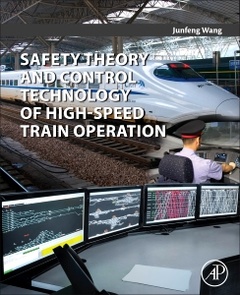Safety Theory and Control Technology of High-Speed Train Operation
Auteur : Wang Junfeng

Safety Theory and Technology of High-Speed Train Operation puts forward solutions for train dispatching and signal control. Frequent railway incidents have threatened the safety of rail transport. In 2013, more than 12 trains collided. In the same year, a Spanish train derailed due to speed, and two of China?s high-speed trains collided. In 2016, Germany and Italy both experienced serious train collisions. Global railway security is essential. Many accidents are caused by train dispatching errors and signal system failure. Chinese high-speed railway has developed very quickly and at a very large scale. However, many issues reagrding safety has not been addressed. This book considers the issue from the perspective of a system. A train operation control system structure is put forward in order to ensure safety. Five key technologies (namely system-level fail-safe, parallel monitoring, completeness of train control data, data sharing and fusion and prevention of common errors in monitoring), are proposed. In order to prevent collision, over-speed, derailment, and rear-end collision accidents, the concept and corresponding parallel monitoring technology of five core control items (train route, speed, tracking interval, temporary speed limit, train running state) is proposed.
2. Existing train safety control technology
3. Theory system and framework of high speed railway train operation safety
4. System-Level Fail-Safe
5. Parallel Monitoring
6. Sigma completeness of train control data
7. Data Sharing, data fusion and avoid common cause failure
8. Real-time supervision and prewarning of train operation status and operation behavior
9. The train operation control and Intelligent dispatch
10. Failure mechanism and risk control of train control system
11. Safety analysis method for train control system
12. Safety evaluation method for train control system
Railway safety managers; control field specialists; railway signal design and standard makers; signal system test and safety evaluation personnel; signal equipment manufacturing, management, operation and maintenance personnel; those involved in the next generation of railway signal technology; researchers, teachers and students specializing in railways; professional railway trainers
- Puts forward solutions for train dispatching and signal control
- Views high-speed train safety and technology from a systems-theory perspective
- Describes five key technologies to ensure safety
- Proposes five parallel monitoring technologies to prevent collision, over-speed, derailment and rear-end collision incidents
- Considers the very quick and large-scale development of Chinese high-speed rail
Date de parution : 10-2017
Ouvrage de 398 p.
19x23.3 cm
Thème de Safety Theory and Control Technology of High-Speed Train... :
Mots-clés :
Auxiliary dispatching; Big data; Centralized signal monitoring; Centralized traffic control; Common cause errors; Control items; Data fusion; Data of train control; Data sharing; Data sigmacompleteness; Development course; Early warning; Emergence; Fail-safe; Failure mechanism; Fault diagnosis; Fault diagnosis method; Geese migration theory; High-speed railway; Integration; Interval block; Key technologies of train safety control; Monitoring; On-board ATP device and ground ATP device; Over-speed protection; Parallel monitoring; Qualitative analysis method; Quantitative analysis method; Risk control; STAMP; STPA; Safety analysis; Safety evaluation; Sigmacompleteness; Signaling system; Station interlocking; System framework of train operation safety; System theory; System-wide fault diagnosis; Systematic safety; Systems science; Test and verification; Train accident; Train control; Train control data; Train control system; Train operation scenario; Train running status; Train safety status; Train safety system; Virtual image technology


